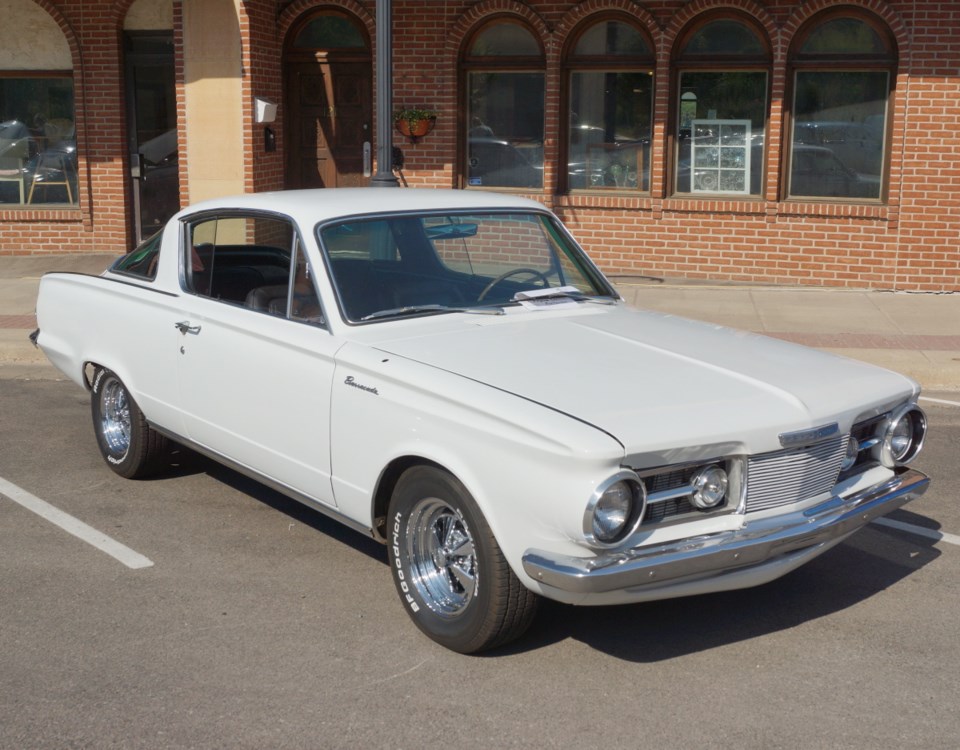When import car sales approached 10 per cent of the North American market in the late 1950s, the Big Three (General Motors, Ford and Chrysler) finally responded. The answer was their 1960 “compact” Ford Falcon, Chevrolet Corvair and Chrysler (soon to be Plymouth) Valiant. The smaller companies, particularly Nash, had reacted much earlier with cars such as Nash’s 1950 Rambler.
It wasn’t long before Ford and Chevrolet developed sportier versions. The Corvair Monza was first, and while little more than a dressed-up Deluxe 700 coupe, it gave the Corvair a brand-new image.
Ford introduced the sporty Falcon Futura and Sprint, and then the even more dramatic Falcon-based Mustang that started the whole pony-car movement.
Chrysler also wanted something sportier, but couldn’t afford an all-new body, à la the Mustang, so it followed Chevrolet and used what it had. It began developing the Valiant-based Barracuda in 1962.
The Valiant was given a modified grille and tail, but the most distinctive features were its fastback styling and a huge “wrap-over” rear window so big it required four vents at its trailing edge to keep the big glass from popping out at high speeds. These also provided flow-through ventilation. At 14.4 square feet, it was the largest backlight ever used in a standard car.
In spite of being basically a Valiant from the waist down, the Barracuda had an entirely different character. Its fastback styling followed the styling theme of cars such as the Studebaker Avanti and Chevrolet Corvette. The trunk lid was very narrow, but the rear seat folded down to accommodate objects up to 2.1 metres long.
The Plymouth Valiant Barracuda (the Valiant part of the name disappeared for 1965) was introduced in May 1964. Unfortunately for Chrysler, it arrived at the same time as the groundbreaking Mustang. But in spite of being overshadowed by the sensational Mustang, the Barracuda gained enough public acceptance to sell 23,443 of the 19641Ú2 models.
Standard power was the corporate 2.8-litre, 101 horsepower, overhead-valve slant six. Options were a 145-horsepower 3.7-litre long-stroke version of the six, or a 4.5-litre, 180-horsepower overhead-valve V-8. Transmissions were a three-speed manual, with optional four-speed manual or three-speed pushbutton automatic.
With the Mustang and Barracuda aiming at the same market, a performance comparison was inevitable. They were not far apart, with the Mustang holding an edge in acceleration and the Barracuda in top speed.
Car Life tested a Barracuda with the 4.5-litre V-8 and automatic and recorded zero to 100 km/h in 12.9 seconds. An earlier test of a Mustang with a 4.5 V-8 and automatic gave zero to 100 in 11.2 seconds. Top speed for the Barracuda was 169 km/h and the Mustang 163.
The Barracuda continued in its original form through the 1966 model year, although an optional 4.5-litre V-8 boosted horsepower from 180 to 235.
For better handling, Chrysler introduced the Barracuda S model in 1965 fitted with larger front torsion bars, stiffer rear springs, heavy-duty shock absorbers and Goodyear Blue Streak tires. In 1966, front disc brakes were made optional.
The second-generation 1967 Barracuda was more conventional, losing the distinctive rear-window treatment although retaining the fastback profile. It was joined by a two-door hardtop coupe and convertible.
By this time, Detroit was into its big-horsepower-in-intermediate-cars muscle-car excesses spawned by the 1964 Pontiac Tempest GTO. Thus, the Barracuda’s small 2.8-litre six was discontinued in 1967, and larger and larger V-8s were fitted to the erstwhile economy car.
By 1969 this had evolved to include a 7.2-litre, 375-horsepower monster V-8, the largest in a pony car. In the hands of a skilled driver, it provided tremendous acceleration, but not much else.
Car Life tested a 440 cu in. (7.2 litre) ’Cuda (a special package option), reporting zero to 100 in 5.6 seconds, but panning it on almost everything else, including braking, handling and steering (the huge engine left no room for power assist).
The 1970 Barracuda was again restyled, now in the more pony car-like long-hood, short-deck fashion. It was 152 mm shorter and 51 mm lower, but 127 mm wider for a chunkier appearance.
Engine options were up to nine, from the 3.7-litre six to the mighty 7.2-litre V-8, and even included the resurrected Hemi V-8. Alas, this third-generation Barracuda arrived as fierce insurance rates and rising environmental concerns were bringing the muscle car and high-powered pony-car era to an end. After a relatively short run, those big-engined compacts disappeared.
Barracuda production steadily declined until it was discontinued on April 1, 1974, after a 10-year production life.



